Analysis of Vertical Mergers: AT&T and Time Warner Deal
VerifiedAdded on 2020/05/01
|7
|1722
|51
Report
AI Summary
This report provides an analysis of vertical mergers, focusing on the case study of the AT&T and Time Warner deal. It begins by defining vertical mergers and their characteristics, explaining how they occur between companies at different levels of a supply chain to increase production synergies and control. The report then delves into the benefits of such mergers, including increased control, simplified production, and potential cost reductions, and discusses forward and backward integration. The core of the report examines the potential benefits of the AT&T and Time Warner merger, highlighting how it could create a massive mobile entertainment business and provide exclusive content. However, the report also explores potential risks, such as the impact of digitization and social media, the transfer of problems rather than solutions, and the need for effective digital strategies. The analysis concludes by emphasizing the importance of strategic planning for companies involved in vertical mergers, particularly in the context of the evolving media landscape.
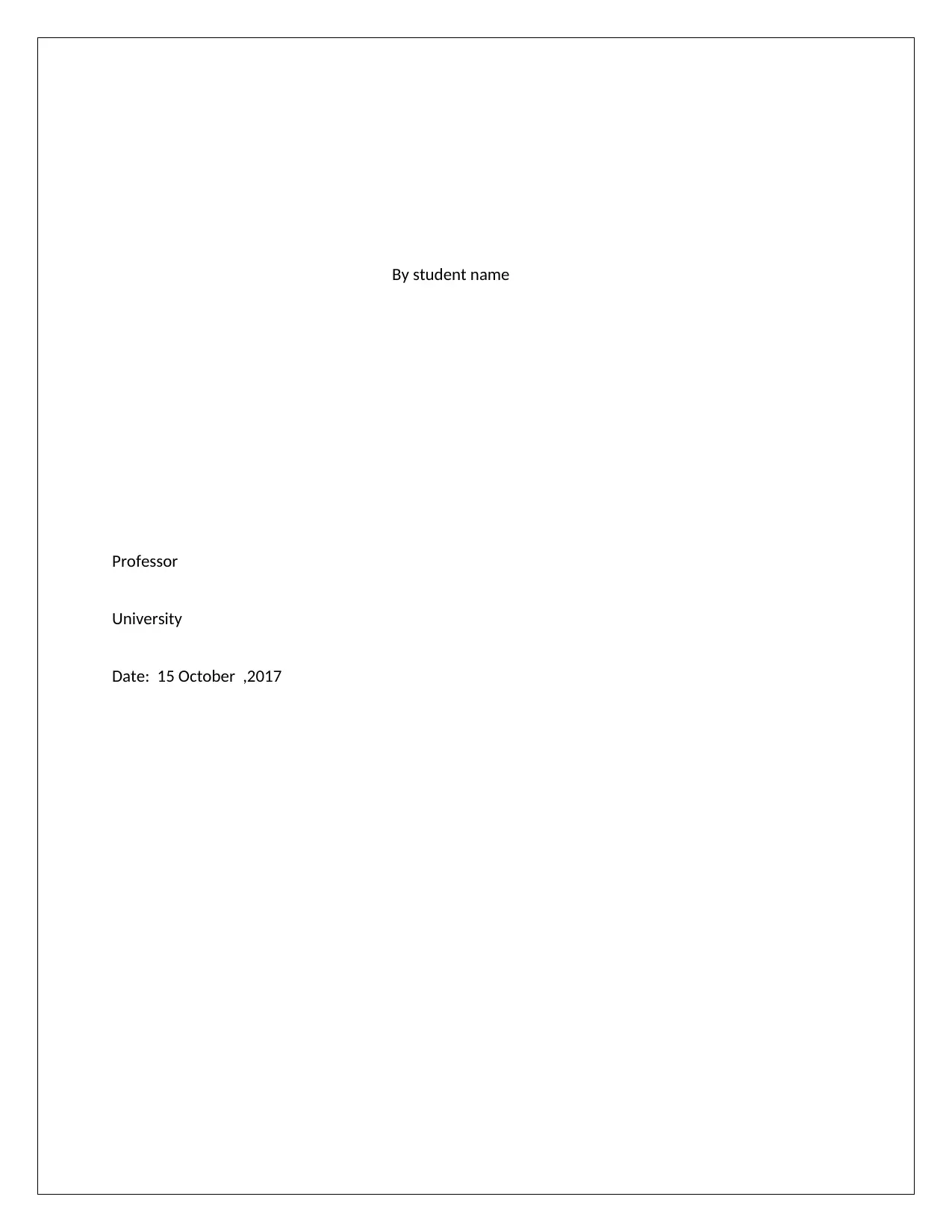
By student name
Professor
University
Date: 15 October ,2017
Professor
University
Date: 15 October ,2017
Paraphrase This Document
Need a fresh take? Get an instant paraphrase of this document with our AI Paraphraser

1
Contents
Question 1…………………………………………………………………………………….2
Question 2…………………………………………………………………………………….3
Refrences……………..…………………………………………………………................6
1 | P a g e
Contents
Question 1…………………………………………………………………………………….2
Question 2…………………………………………………………………………………….3
Refrences……………..…………………………………………………………................6
1 | P a g e
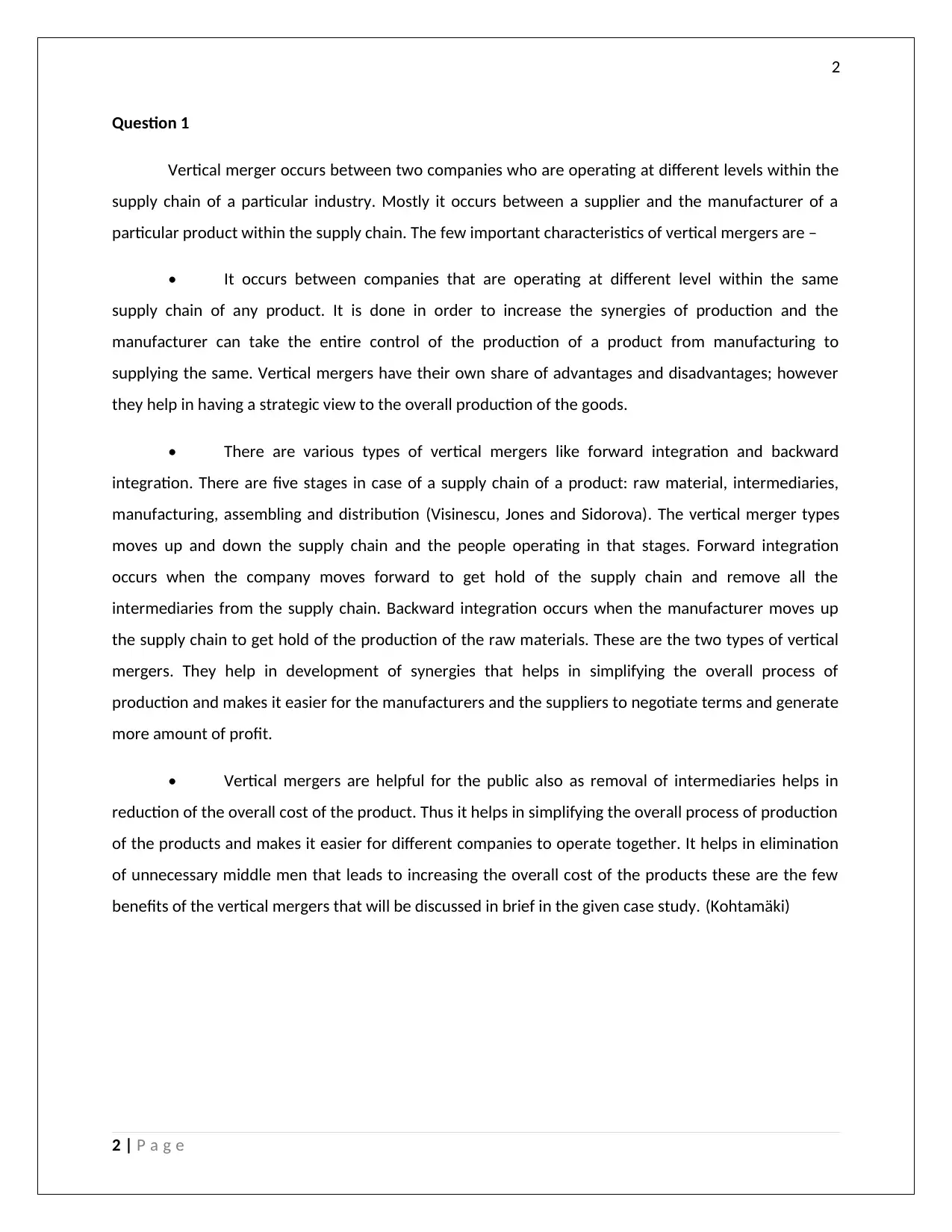
2
Question 1
Vertical merger occurs between two companies who are operating at different levels within the
supply chain of a particular industry. Mostly it occurs between a supplier and the manufacturer of a
particular product within the supply chain. The few important characteristics of vertical mergers are –
• It occurs between companies that are operating at different level within the same
supply chain of any product. It is done in order to increase the synergies of production and the
manufacturer can take the entire control of the production of a product from manufacturing to
supplying the same. Vertical mergers have their own share of advantages and disadvantages; however
they help in having a strategic view to the overall production of the goods.
• There are various types of vertical mergers like forward integration and backward
integration. There are five stages in case of a supply chain of a product: raw material, intermediaries,
manufacturing, assembling and distribution (Visinescu, Jones and Sidorova). The vertical merger types
moves up and down the supply chain and the people operating in that stages. Forward integration
occurs when the company moves forward to get hold of the supply chain and remove all the
intermediaries from the supply chain. Backward integration occurs when the manufacturer moves up
the supply chain to get hold of the production of the raw materials. These are the two types of vertical
mergers. They help in development of synergies that helps in simplifying the overall process of
production and makes it easier for the manufacturers and the suppliers to negotiate terms and generate
more amount of profit.
• Vertical mergers are helpful for the public also as removal of intermediaries helps in
reduction of the overall cost of the product. Thus it helps in simplifying the overall process of production
of the products and makes it easier for different companies to operate together. It helps in elimination
of unnecessary middle men that leads to increasing the overall cost of the products these are the few
benefits of the vertical mergers that will be discussed in brief in the given case study. (Kohtamäki)
2 | P a g e
Question 1
Vertical merger occurs between two companies who are operating at different levels within the
supply chain of a particular industry. Mostly it occurs between a supplier and the manufacturer of a
particular product within the supply chain. The few important characteristics of vertical mergers are –
• It occurs between companies that are operating at different level within the same
supply chain of any product. It is done in order to increase the synergies of production and the
manufacturer can take the entire control of the production of a product from manufacturing to
supplying the same. Vertical mergers have their own share of advantages and disadvantages; however
they help in having a strategic view to the overall production of the goods.
• There are various types of vertical mergers like forward integration and backward
integration. There are five stages in case of a supply chain of a product: raw material, intermediaries,
manufacturing, assembling and distribution (Visinescu, Jones and Sidorova). The vertical merger types
moves up and down the supply chain and the people operating in that stages. Forward integration
occurs when the company moves forward to get hold of the supply chain and remove all the
intermediaries from the supply chain. Backward integration occurs when the manufacturer moves up
the supply chain to get hold of the production of the raw materials. These are the two types of vertical
mergers. They help in development of synergies that helps in simplifying the overall process of
production and makes it easier for the manufacturers and the suppliers to negotiate terms and generate
more amount of profit.
• Vertical mergers are helpful for the public also as removal of intermediaries helps in
reduction of the overall cost of the product. Thus it helps in simplifying the overall process of production
of the products and makes it easier for different companies to operate together. It helps in elimination
of unnecessary middle men that leads to increasing the overall cost of the products these are the few
benefits of the vertical mergers that will be discussed in brief in the given case study. (Kohtamäki)
2 | P a g e
⊘ This is a preview!⊘
Do you want full access?
Subscribe today to unlock all pages.

Trusted by 1+ million students worldwide
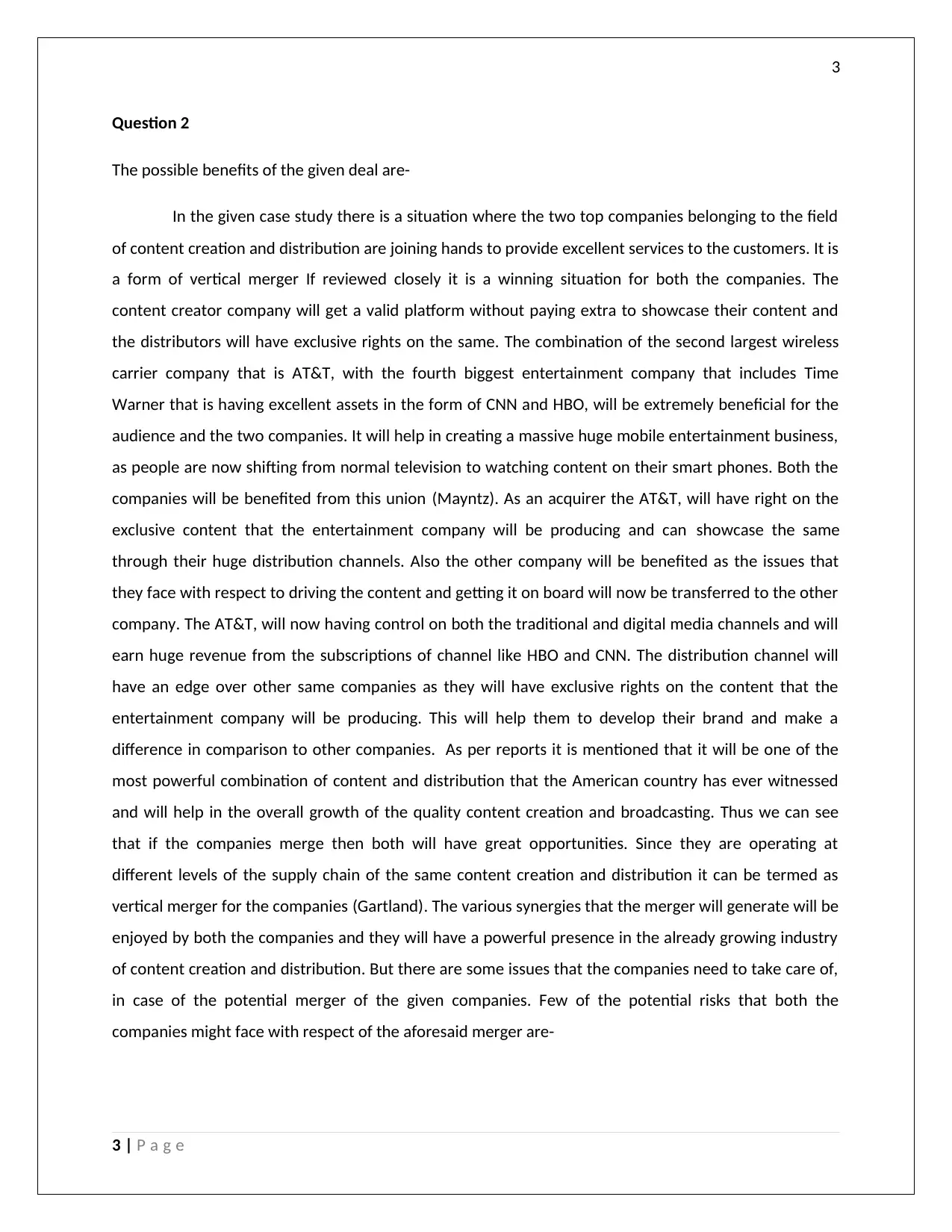
3
Question 2
The possible benefits of the given deal are-
In the given case study there is a situation where the two top companies belonging to the field
of content creation and distribution are joining hands to provide excellent services to the customers. It is
a form of vertical merger If reviewed closely it is a winning situation for both the companies. The
content creator company will get a valid platform without paying extra to showcase their content and
the distributors will have exclusive rights on the same. The combination of the second largest wireless
carrier company that is AT&T, with the fourth biggest entertainment company that includes Time
Warner that is having excellent assets in the form of CNN and HBO, will be extremely beneficial for the
audience and the two companies. It will help in creating a massive huge mobile entertainment business,
as people are now shifting from normal television to watching content on their smart phones. Both the
companies will be benefited from this union (Mayntz). As an acquirer the AT&T, will have right on the
exclusive content that the entertainment company will be producing and can showcase the same
through their huge distribution channels. Also the other company will be benefited as the issues that
they face with respect to driving the content and getting it on board will now be transferred to the other
company. The AT&T, will now having control on both the traditional and digital media channels and will
earn huge revenue from the subscriptions of channel like HBO and CNN. The distribution channel will
have an edge over other same companies as they will have exclusive rights on the content that the
entertainment company will be producing. This will help them to develop their brand and make a
difference in comparison to other companies. As per reports it is mentioned that it will be one of the
most powerful combination of content and distribution that the American country has ever witnessed
and will help in the overall growth of the quality content creation and broadcasting. Thus we can see
that if the companies merge then both will have great opportunities. Since they are operating at
different levels of the supply chain of the same content creation and distribution it can be termed as
vertical merger for the companies (Gartland). The various synergies that the merger will generate will be
enjoyed by both the companies and they will have a powerful presence in the already growing industry
of content creation and distribution. But there are some issues that the companies need to take care of,
in case of the potential merger of the given companies. Few of the potential risks that both the
companies might face with respect of the aforesaid merger are-
3 | P a g e
Question 2
The possible benefits of the given deal are-
In the given case study there is a situation where the two top companies belonging to the field
of content creation and distribution are joining hands to provide excellent services to the customers. It is
a form of vertical merger If reviewed closely it is a winning situation for both the companies. The
content creator company will get a valid platform without paying extra to showcase their content and
the distributors will have exclusive rights on the same. The combination of the second largest wireless
carrier company that is AT&T, with the fourth biggest entertainment company that includes Time
Warner that is having excellent assets in the form of CNN and HBO, will be extremely beneficial for the
audience and the two companies. It will help in creating a massive huge mobile entertainment business,
as people are now shifting from normal television to watching content on their smart phones. Both the
companies will be benefited from this union (Mayntz). As an acquirer the AT&T, will have right on the
exclusive content that the entertainment company will be producing and can showcase the same
through their huge distribution channels. Also the other company will be benefited as the issues that
they face with respect to driving the content and getting it on board will now be transferred to the other
company. The AT&T, will now having control on both the traditional and digital media channels and will
earn huge revenue from the subscriptions of channel like HBO and CNN. The distribution channel will
have an edge over other same companies as they will have exclusive rights on the content that the
entertainment company will be producing. This will help them to develop their brand and make a
difference in comparison to other companies. As per reports it is mentioned that it will be one of the
most powerful combination of content and distribution that the American country has ever witnessed
and will help in the overall growth of the quality content creation and broadcasting. Thus we can see
that if the companies merge then both will have great opportunities. Since they are operating at
different levels of the supply chain of the same content creation and distribution it can be termed as
vertical merger for the companies (Gartland). The various synergies that the merger will generate will be
enjoyed by both the companies and they will have a powerful presence in the already growing industry
of content creation and distribution. But there are some issues that the companies need to take care of,
in case of the potential merger of the given companies. Few of the potential risks that both the
companies might face with respect of the aforesaid merger are-
3 | P a g e
Paraphrase This Document
Need a fresh take? Get an instant paraphrase of this document with our AI Paraphraser
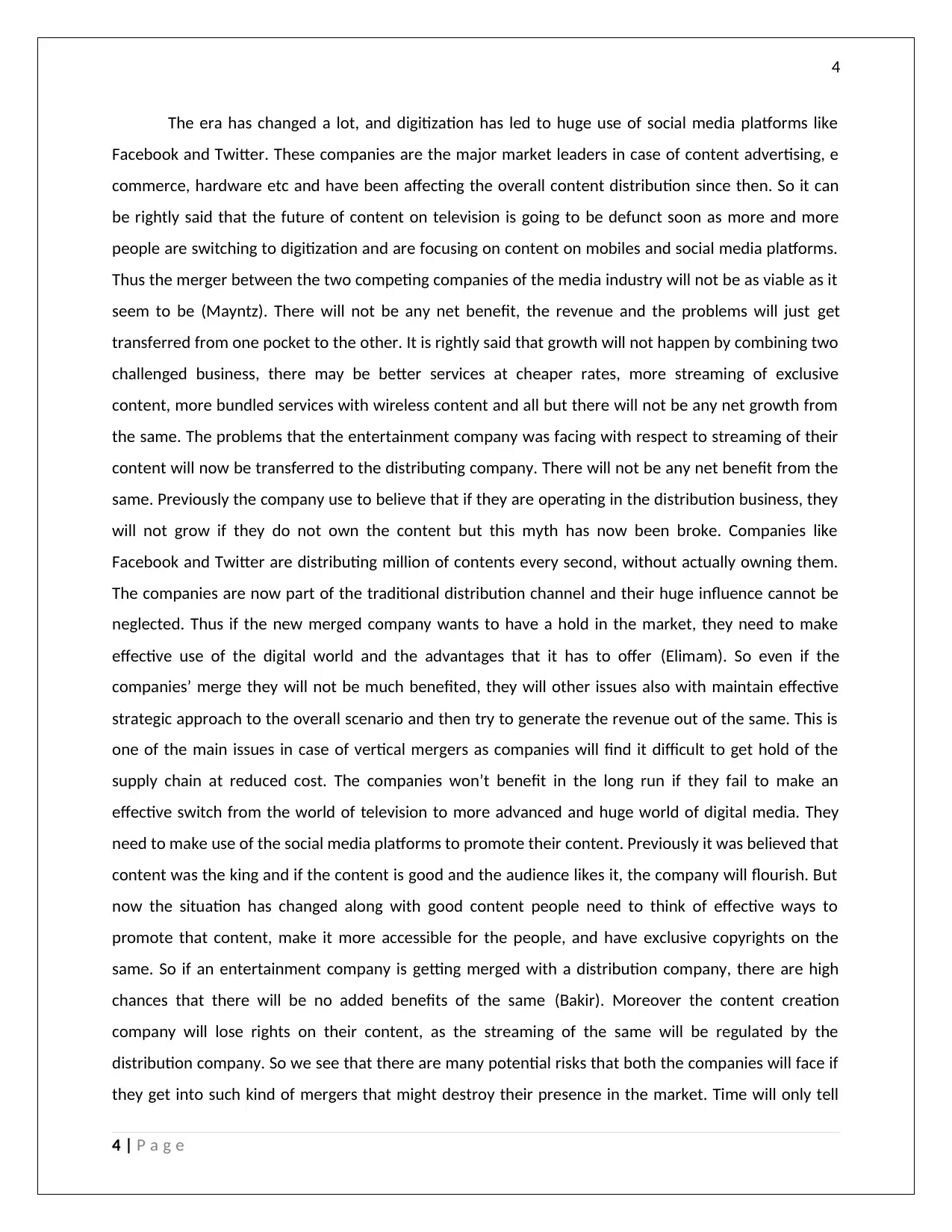
4
The era has changed a lot, and digitization has led to huge use of social media platforms like
Facebook and Twitter. These companies are the major market leaders in case of content advertising, e
commerce, hardware etc and have been affecting the overall content distribution since then. So it can
be rightly said that the future of content on television is going to be defunct soon as more and more
people are switching to digitization and are focusing on content on mobiles and social media platforms.
Thus the merger between the two competing companies of the media industry will not be as viable as it
seem to be (Mayntz). There will not be any net benefit, the revenue and the problems will just get
transferred from one pocket to the other. It is rightly said that growth will not happen by combining two
challenged business, there may be better services at cheaper rates, more streaming of exclusive
content, more bundled services with wireless content and all but there will not be any net growth from
the same. The problems that the entertainment company was facing with respect to streaming of their
content will now be transferred to the distributing company. There will not be any net benefit from the
same. Previously the company use to believe that if they are operating in the distribution business, they
will not grow if they do not own the content but this myth has now been broke. Companies like
Facebook and Twitter are distributing million of contents every second, without actually owning them.
The companies are now part of the traditional distribution channel and their huge influence cannot be
neglected. Thus if the new merged company wants to have a hold in the market, they need to make
effective use of the digital world and the advantages that it has to offer (Elimam). So even if the
companies’ merge they will not be much benefited, they will other issues also with maintain effective
strategic approach to the overall scenario and then try to generate the revenue out of the same. This is
one of the main issues in case of vertical mergers as companies will find it difficult to get hold of the
supply chain at reduced cost. The companies won’t benefit in the long run if they fail to make an
effective switch from the world of television to more advanced and huge world of digital media. They
need to make use of the social media platforms to promote their content. Previously it was believed that
content was the king and if the content is good and the audience likes it, the company will flourish. But
now the situation has changed along with good content people need to think of effective ways to
promote that content, make it more accessible for the people, and have exclusive copyrights on the
same. So if an entertainment company is getting merged with a distribution company, there are high
chances that there will be no added benefits of the same (Bakir). Moreover the content creation
company will lose rights on their content, as the streaming of the same will be regulated by the
distribution company. So we see that there are many potential risks that both the companies will face if
they get into such kind of mergers that might destroy their presence in the market. Time will only tell
4 | P a g e
The era has changed a lot, and digitization has led to huge use of social media platforms like
Facebook and Twitter. These companies are the major market leaders in case of content advertising, e
commerce, hardware etc and have been affecting the overall content distribution since then. So it can
be rightly said that the future of content on television is going to be defunct soon as more and more
people are switching to digitization and are focusing on content on mobiles and social media platforms.
Thus the merger between the two competing companies of the media industry will not be as viable as it
seem to be (Mayntz). There will not be any net benefit, the revenue and the problems will just get
transferred from one pocket to the other. It is rightly said that growth will not happen by combining two
challenged business, there may be better services at cheaper rates, more streaming of exclusive
content, more bundled services with wireless content and all but there will not be any net growth from
the same. The problems that the entertainment company was facing with respect to streaming of their
content will now be transferred to the distributing company. There will not be any net benefit from the
same. Previously the company use to believe that if they are operating in the distribution business, they
will not grow if they do not own the content but this myth has now been broke. Companies like
Facebook and Twitter are distributing million of contents every second, without actually owning them.
The companies are now part of the traditional distribution channel and their huge influence cannot be
neglected. Thus if the new merged company wants to have a hold in the market, they need to make
effective use of the digital world and the advantages that it has to offer (Elimam). So even if the
companies’ merge they will not be much benefited, they will other issues also with maintain effective
strategic approach to the overall scenario and then try to generate the revenue out of the same. This is
one of the main issues in case of vertical mergers as companies will find it difficult to get hold of the
supply chain at reduced cost. The companies won’t benefit in the long run if they fail to make an
effective switch from the world of television to more advanced and huge world of digital media. They
need to make use of the social media platforms to promote their content. Previously it was believed that
content was the king and if the content is good and the audience likes it, the company will flourish. But
now the situation has changed along with good content people need to think of effective ways to
promote that content, make it more accessible for the people, and have exclusive copyrights on the
same. So if an entertainment company is getting merged with a distribution company, there are high
chances that there will be no added benefits of the same (Bakir). Moreover the content creation
company will lose rights on their content, as the streaming of the same will be regulated by the
distribution company. So we see that there are many potential risks that both the companies will face if
they get into such kind of mergers that might destroy their presence in the market. Time will only tell
4 | P a g e

5
whether this will be a viable deal or not, however on close scrutiny it can only be said that the
companies need to strategize the overall union if they want to earn any kind of synergy from the said
merger of content creation and development and distribution (Belton).
5 | P a g e
whether this will be a viable deal or not, however on close scrutiny it can only be said that the
companies need to strategize the overall union if they want to earn any kind of synergy from the said
merger of content creation and development and distribution (Belton).
5 | P a g e
⊘ This is a preview!⊘
Do you want full access?
Subscribe today to unlock all pages.

Trusted by 1+ million students worldwide
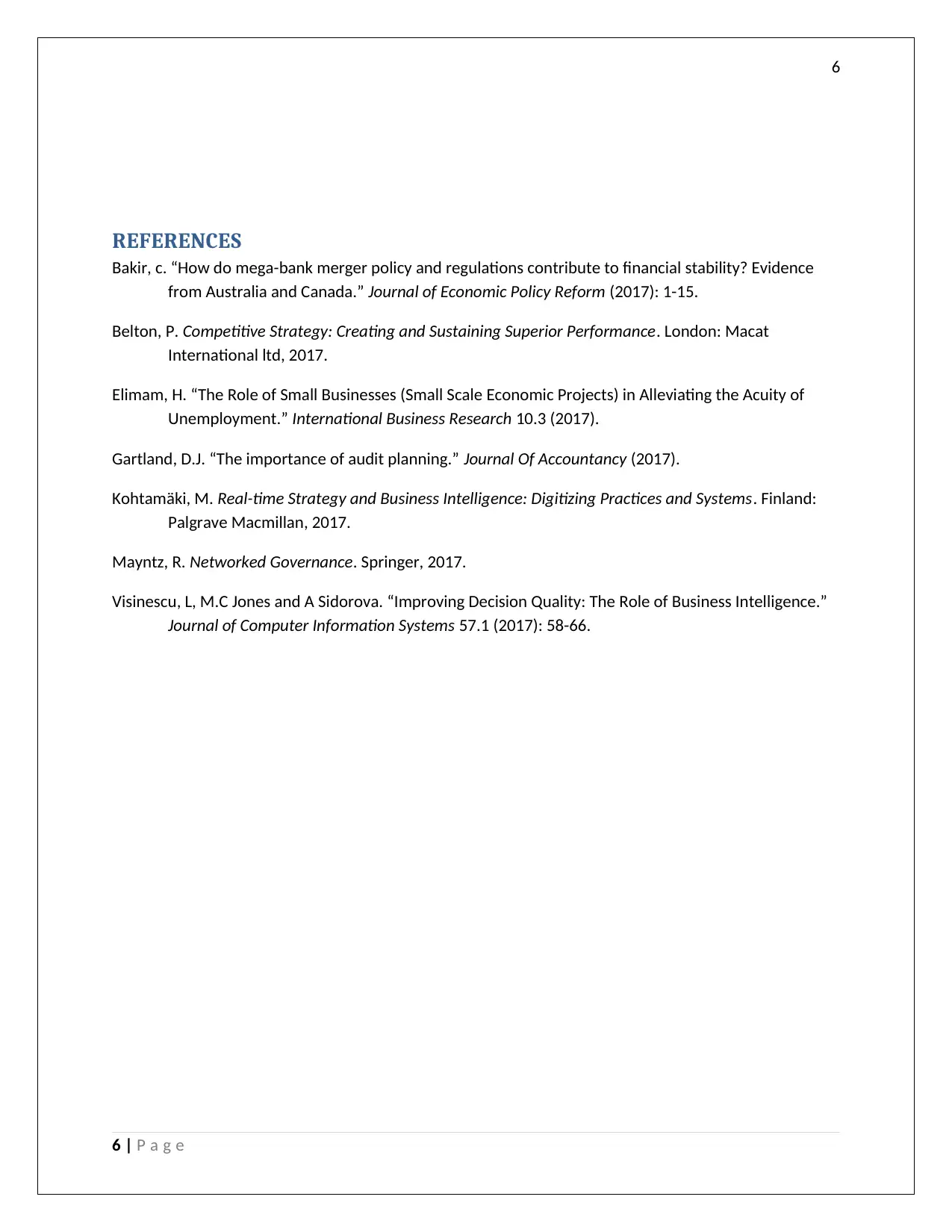
6
REFERENCES
Bakir, c. “How do mega-bank merger policy and regulations contribute to financial stability? Evidence
from Australia and Canada.” Journal of Economic Policy Reform (2017): 1-15.
Belton, P. Competitive Strategy: Creating and Sustaining Superior Performance. London: Macat
International ltd, 2017.
Elimam, H. “The Role of Small Businesses (Small Scale Economic Projects) in Alleviating the Acuity of
Unemployment.” International Business Research 10.3 (2017).
Gartland, D.J. “The importance of audit planning.” Journal Of Accountancy (2017).
Kohtamäki, M. Real-time Strategy and Business Intelligence: Digitizing Practices and Systems. Finland:
Palgrave Macmillan, 2017.
Mayntz, R. Networked Governance. Springer, 2017.
Visinescu, L, M.C Jones and A Sidorova. “Improving Decision Quality: The Role of Business Intelligence.”
Journal of Computer Information Systems 57.1 (2017): 58-66.
6 | P a g e
REFERENCES
Bakir, c. “How do mega-bank merger policy and regulations contribute to financial stability? Evidence
from Australia and Canada.” Journal of Economic Policy Reform (2017): 1-15.
Belton, P. Competitive Strategy: Creating and Sustaining Superior Performance. London: Macat
International ltd, 2017.
Elimam, H. “The Role of Small Businesses (Small Scale Economic Projects) in Alleviating the Acuity of
Unemployment.” International Business Research 10.3 (2017).
Gartland, D.J. “The importance of audit planning.” Journal Of Accountancy (2017).
Kohtamäki, M. Real-time Strategy and Business Intelligence: Digitizing Practices and Systems. Finland:
Palgrave Macmillan, 2017.
Mayntz, R. Networked Governance. Springer, 2017.
Visinescu, L, M.C Jones and A Sidorova. “Improving Decision Quality: The Role of Business Intelligence.”
Journal of Computer Information Systems 57.1 (2017): 58-66.
6 | P a g e
1 out of 7
Related Documents
Your All-in-One AI-Powered Toolkit for Academic Success.
+13062052269
info@desklib.com
Available 24*7 on WhatsApp / Email
![[object Object]](/_next/static/media/star-bottom.7253800d.svg)
Unlock your academic potential
Copyright © 2020–2025 A2Z Services. All Rights Reserved. Developed and managed by ZUCOL.





